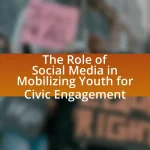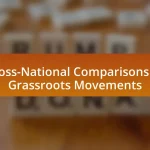Grassroots movements are collective actions initiated by ordinary individuals at the community level to address social, political, or environmental issues. This article explores notable case studies of successful grassroots movements worldwide, including the Civil Rights Movement in the United States, the anti-apartheid movement in South Africa, and the Green Belt Movement in Kenya. It examines the characteristics that define grassroots movements, their importance for social change, and the role of community engagement and local leadership in their success. Additionally, the article discusses effective strategies for mobilization, the challenges these movements face, and best practices that enhance their impact.
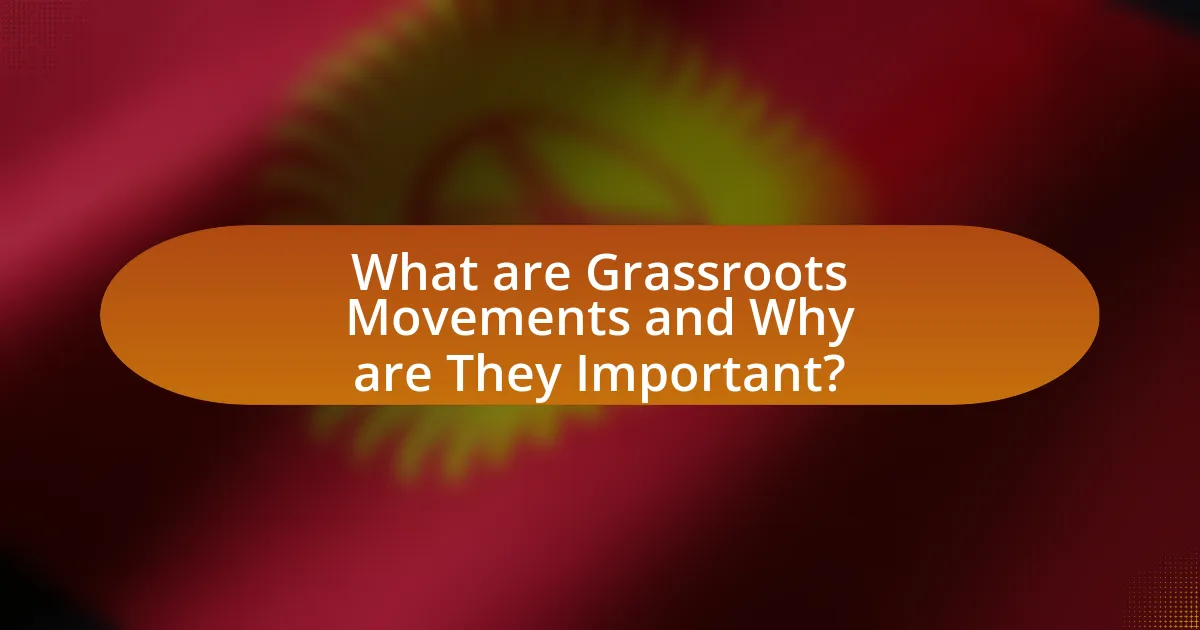
What are Grassroots Movements and Why are They Important?
Grassroots movements are collective actions initiated by ordinary people at the community level to address social, political, or environmental issues. These movements are important because they empower individuals to influence change, often leading to significant societal transformations, as seen in historical examples like the Civil Rights Movement in the United States, which mobilized citizens to advocate for racial equality and resulted in landmark legislation such as the Civil Rights Act of 1964. Grassroots movements often operate outside traditional political structures, allowing for diverse voices to be heard and fostering community engagement, which can lead to sustainable change and increased civic participation.
How do grassroots movements differ from traditional activism?
Grassroots movements differ from traditional activism primarily in their structure and approach to mobilization. Grassroots movements are typically community-driven, relying on local participation and collective action from individuals at the base level, whereas traditional activism often involves established organizations or institutions that lead campaigns and initiatives. For example, the Civil Rights Movement in the United States was largely grassroots, with local leaders and community members organizing protests and sit-ins, while traditional activism can be seen in structured organizations like the Sierra Club, which has a formal hierarchy and established protocols for advocacy. This distinction highlights how grassroots movements prioritize direct engagement and local empowerment, contrasting with the top-down strategies often employed by traditional activist organizations.
What characteristics define a grassroots movement?
A grassroots movement is characterized by its community-driven nature, where ordinary individuals mobilize to effect social or political change. These movements typically emerge from local communities, relying on collective action and participation rather than top-down leadership. They often prioritize inclusivity, empowering marginalized voices and fostering a sense of ownership among participants. Additionally, grassroots movements utilize grassroots organizing strategies, such as door-to-door campaigning and community meetings, to build support and raise awareness. Historical examples, like the Civil Rights Movement in the United States, illustrate how grassroots efforts can lead to significant societal transformations, demonstrating the effectiveness of local engagement in driving change.
Why are grassroots movements essential for social change?
Grassroots movements are essential for social change because they empower individuals at the community level to advocate for their rights and influence policy. These movements often arise from the collective experiences and needs of marginalized groups, allowing them to mobilize resources, raise awareness, and create pressure for change. For instance, the Civil Rights Movement in the United States, which was largely driven by grassroots organizations, successfully challenged systemic racism and led to significant legislative changes, such as the Civil Rights Act of 1964. This demonstrates that grassroots movements can effectively address social injustices and drive transformative change through community engagement and collective action.
What role do community engagement and local leadership play?
Community engagement and local leadership are crucial for the success of grassroots movements, as they foster collaboration, build trust, and empower individuals to take action. Effective community engagement ensures that the voices of local residents are heard, leading to initiatives that reflect their needs and priorities. Local leadership provides direction and mobilizes resources, enabling communities to organize effectively and advocate for change. For instance, the community-led initiatives in the 2011 Arab Spring demonstrated how local leaders could galvanize public support and coordinate protests, resulting in significant political change. This illustrates that when communities actively participate and are guided by strong local leaders, they can drive impactful social movements.
How does local leadership influence the success of grassroots movements?
Local leadership significantly influences the success of grassroots movements by providing direction, mobilizing community support, and fostering trust among participants. Effective local leaders understand the unique needs and dynamics of their communities, which enables them to tailor strategies that resonate with local values and concerns. For instance, the Civil Rights Movement in the United States saw local leaders like Martin Luther King Jr. and Rosa Parks galvanizing community action through their deep connections and understanding of local issues, leading to significant legislative changes. Research indicates that grassroots movements with strong local leadership are more likely to achieve their goals, as evidenced by the success of the anti-apartheid movement in South Africa, where local leaders played crucial roles in organizing protests and building coalitions.
What strategies enhance community engagement in grassroots initiatives?
Strategies that enhance community engagement in grassroots initiatives include fostering inclusive participation, utilizing social media for outreach, and building partnerships with local organizations. Inclusive participation ensures that diverse voices are heard, which can increase buy-in and support; for example, the Black Lives Matter movement effectively engaged various community members to amplify their message. Social media serves as a powerful tool for outreach, allowing grassroots movements to mobilize quickly and share information widely, as seen in the Arab Spring where platforms like Twitter facilitated rapid organization. Building partnerships with local organizations can also strengthen initiatives by leveraging existing networks and resources, exemplified by the collaboration between local nonprofits and community members in the fight against food deserts in urban areas. These strategies collectively create a more engaged and active community, leading to more successful grassroots initiatives.

What are Some Notable Case Studies of Successful Grassroots Movements?
Notable case studies of successful grassroots movements include the Civil Rights Movement in the United States, which effectively mobilized citizens to advocate for racial equality and led to significant legislative changes such as the Civil Rights Act of 1964. Another example is the anti-apartheid movement in South Africa, where grassroots activism played a crucial role in dismantling institutionalized racial segregation, culminating in the election of Nelson Mandela in 1994. Additionally, the women’s suffrage movement, particularly in the early 20th century, successfully campaigned for women’s right to vote, resulting in the passage of the 19th Amendment in the U.S. in 1920. These movements demonstrate the power of collective action in achieving social and political change.
How did the Civil Rights Movement in the United States achieve its goals?
The Civil Rights Movement in the United States achieved its goals through a combination of grassroots activism, legal challenges, and legislative advocacy. Activists organized protests, marches, and sit-ins, notably the 1963 March on Washington, which drew over 250,000 participants and highlighted demands for racial equality. Legal victories, such as the Supreme Court’s decision in Brown v. Board of Education (1954), which declared racial segregation in public schools unconstitutional, provided a judicial foundation for further reforms. Additionally, the passage of landmark legislation, including the Civil Rights Act of 1964 and the Voting Rights Act of 1965, codified protections against discrimination and ensured voting rights for African Americans, solidifying the movement’s achievements.
What key strategies were employed by leaders during the Civil Rights Movement?
Key strategies employed by leaders during the Civil Rights Movement included nonviolent protest, grassroots organizing, and legal challenges. Nonviolent protest, exemplified by events such as the Montgomery Bus Boycott and the March on Washington, aimed to draw national attention to racial injustices while maintaining moral high ground. Grassroots organizing involved mobilizing local communities to participate in demonstrations and voter registration drives, significantly increasing African American voter turnout. Legal challenges, such as those led by the NAACP, sought to dismantle segregation laws through landmark court cases like Brown v. Board of Education, which declared racial segregation in public schools unconstitutional. These strategies collectively advanced the cause of civil rights and led to significant legislative changes, including the Civil Rights Act of 1964 and the Voting Rights Act of 1965.
What impact did grassroots organizing have on legislation and public opinion?
Grassroots organizing significantly influenced legislation and public opinion by mobilizing communities to advocate for change, resulting in tangible policy shifts and increased awareness of social issues. For instance, the Civil Rights Movement in the United States, driven by grassroots efforts, led to the passage of the Civil Rights Act of 1964 and the Voting Rights Act of 1965, demonstrating how organized local activism can reshape national laws. Additionally, grassroots campaigns like the Fight for $15 have shifted public opinion on minimum wage, leading to legislative changes in various states and cities, reflecting the power of collective action in driving policy reform and altering societal attitudes.
What can we learn from the anti-apartheid movement in South Africa?
The anti-apartheid movement in South Africa teaches us the power of collective action and sustained resistance against systemic injustice. This movement, which spanned several decades, mobilized diverse groups, including labor unions, student organizations, and international allies, demonstrating that unity across various demographics can effectively challenge oppressive regimes. The movement’s success in dismantling apartheid in 1994, marked by the election of Nelson Mandela as the first Black president, illustrates the importance of strategic nonviolent protest, international solidarity, and grassroots organizing in achieving social change. The global boycott and divestment campaigns against South African goods further highlight how economic pressure can complement local activism to bring about political transformation.
How did grassroots mobilization contribute to the end of apartheid?
Grassroots mobilization significantly contributed to the end of apartheid by uniting diverse communities in collective action against racial oppression. This mobilization included mass protests, strikes, and the formation of organizations like the United Democratic Front, which galvanized public support and international attention. Notably, the 1989 mass mobilization led to the release of Nelson Mandela and the eventual dismantling of apartheid laws, demonstrating the power of organized grassroots efforts in challenging systemic injustice.
What role did international solidarity play in supporting the movement?
International solidarity significantly bolstered the movement by providing essential resources, advocacy, and global awareness. For instance, during the anti-apartheid struggle in South Africa, international campaigns led by organizations like the African National Congress garnered widespread support, resulting in economic sanctions and cultural boycotts against the apartheid regime. This global pressure was instrumental in mobilizing local activists and sustaining their efforts, ultimately contributing to the dismantling of apartheid in the early 1990s. Such examples illustrate how international solidarity can amplify grassroots movements, enabling them to achieve their goals through collective action and support from the global community.
What successes have been seen in environmental grassroots movements?
Environmental grassroots movements have achieved significant successes, including the establishment of protected areas and the implementation of sustainable practices. For instance, the Chipko Movement in India successfully led to the protection of forests by mobilizing local communities to embrace conservation efforts, resulting in the preservation of over 1,000 square kilometers of forest land. Additionally, the anti-fracking movement in the United States has resulted in numerous local bans on hydraulic fracturing, with over 1,000 municipalities enacting such measures, showcasing the power of community advocacy in influencing environmental policy. These examples illustrate how grassroots movements can effectively drive environmental change and policy reform.
How did the Green Belt Movement in Kenya empower local communities?
The Green Belt Movement in Kenya empowered local communities by promoting environmental conservation and sustainable development through tree planting initiatives. This grassroots movement, founded by Wangari Maathai in 1977, mobilized women and local residents to plant over 51 million trees, which not only restored degraded lands but also provided economic benefits through the creation of nurseries and sustainable agricultural practices. The movement fostered community engagement and leadership, enhancing social cohesion and giving individuals a voice in environmental decision-making. Furthermore, it raised awareness about the importance of environmental stewardship, leading to improved livelihoods and increased resilience against climate change impacts.
What strategies were effective in raising awareness about environmental issues?
Effective strategies for raising awareness about environmental issues include grassroots organizing, social media campaigns, and educational initiatives. Grassroots organizing mobilizes local communities to advocate for environmental protection, exemplified by movements like the Sierra Club, which has successfully engaged citizens in conservation efforts. Social media campaigns leverage platforms to disseminate information rapidly, as seen in the #FridaysForFuture movement, which has inspired global youth participation in climate action. Educational initiatives, such as workshops and school programs, inform individuals about environmental challenges and solutions, contributing to a more informed public. These strategies collectively enhance public engagement and foster a culture of environmental stewardship.
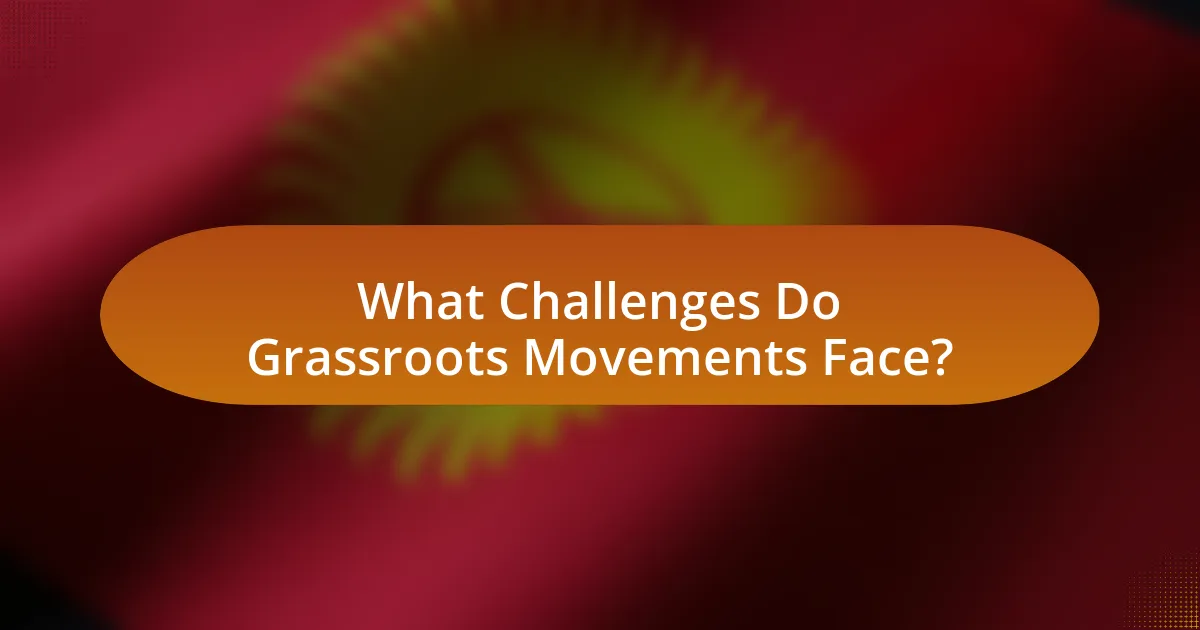
What Challenges Do Grassroots Movements Face?
Grassroots movements face significant challenges, including limited funding, lack of media coverage, and internal conflicts. Limited funding restricts their ability to mobilize resources effectively, as many rely on small donations or volunteer efforts. Lack of media coverage can hinder their visibility and outreach, making it difficult to gain public support and influence policy. Internal conflicts, such as differing priorities among members, can lead to fragmentation and weaken the movement’s overall impact. These challenges are evident in various case studies, where movements struggled to maintain momentum due to financial constraints or disunity among participants.
What obstacles hinder the effectiveness of grassroots movements?
Grassroots movements face several obstacles that hinder their effectiveness, including limited funding, lack of media coverage, and internal conflicts. Limited funding restricts the ability of grassroots organizations to mobilize resources, conduct outreach, and sustain long-term initiatives. For instance, a study by the National Committee for Responsive Philanthropy found that grassroots organizations receive only a small fraction of total philanthropic funding, which hampers their operational capacity. Lack of media coverage can prevent grassroots movements from gaining visibility and support, as mainstream media often prioritizes larger, more established organizations. Additionally, internal conflicts, such as differing priorities among members or leadership disputes, can undermine cohesion and effectiveness, as seen in various case studies where movements have splintered due to these issues.
How do funding and resource limitations impact grassroots initiatives?
Funding and resource limitations significantly hinder grassroots initiatives by restricting their operational capacity and outreach. These limitations often lead to reduced staffing, inadequate training, and insufficient materials, which can diminish the effectiveness of community engagement efforts. For instance, a study by the National Committee for Responsive Philanthropy found that organizations with limited funding struggle to sustain programs, resulting in a 50% decrease in community impact over time. Consequently, grassroots movements may fail to achieve their objectives, limiting their ability to drive social change and address local issues effectively.
What role does political opposition play in the challenges faced?
Political opposition plays a critical role in the challenges faced by grassroots movements, often acting as both a catalyst for mobilization and a source of resistance. When political opposition is present, it can galvanize grassroots movements by highlighting systemic issues and injustices, thereby increasing public awareness and support. For instance, in the case of the Civil Rights Movement in the United States, opposition from segregationist policies and figures prompted activists to organize more effectively and draw national attention to their cause. Conversely, political opposition can also create significant obstacles, such as repression, legal challenges, and public discrediting of movement leaders. The Tiananmen Square protests in China exemplify this, where the government’s strong opposition led to violent suppression, illustrating how political resistance can severely hinder grassroots efforts. Thus, political opposition shapes the landscape in which grassroots movements operate, influencing both their strategies and outcomes.
How can grassroots movements overcome these challenges?
Grassroots movements can overcome challenges by building strong community networks and leveraging social media for mobilization. Effective communication fosters solidarity and encourages participation, as seen in the Arab Spring, where social media platforms played a crucial role in organizing protests and disseminating information rapidly. Additionally, grassroots movements can secure funding through crowdfunding and local partnerships, which enhances their sustainability and reach. For instance, the Black Lives Matter movement successfully utilized online fundraising to support its initiatives, demonstrating the power of community-driven financial support. By focusing on local issues and engaging diverse stakeholders, grassroots movements can create inclusive strategies that resonate with broader audiences, ultimately leading to greater impact and resilience against challenges.
What strategies can be employed to secure funding and resources?
To secure funding and resources, grassroots movements can employ strategies such as building strong community networks, leveraging social media for outreach, and applying for grants. Strong community networks enhance trust and collaboration, which can attract local donations and volunteer support. For instance, the Black Lives Matter movement utilized social media platforms to mobilize supporters and raise funds, demonstrating the effectiveness of digital outreach. Additionally, applying for grants from foundations that support social justice initiatives can provide substantial financial backing; for example, the Ford Foundation has funded various grassroots movements, highlighting the importance of targeted grant applications.
How can movements build coalitions to strengthen their impact?
Movements can build coalitions to strengthen their impact by fostering collaboration among diverse groups that share common goals. This collaboration enhances resource sharing, amplifies voices, and increases visibility, which can lead to greater influence on policy and public opinion. For instance, the Civil Rights Movement in the United States successfully united various organizations, such as the NAACP and SCLC, to advocate for racial equality, demonstrating that collective action can lead to significant legislative changes, such as the Civil Rights Act of 1964. By leveraging each group’s strengths and networks, movements can create a more formidable force for change.
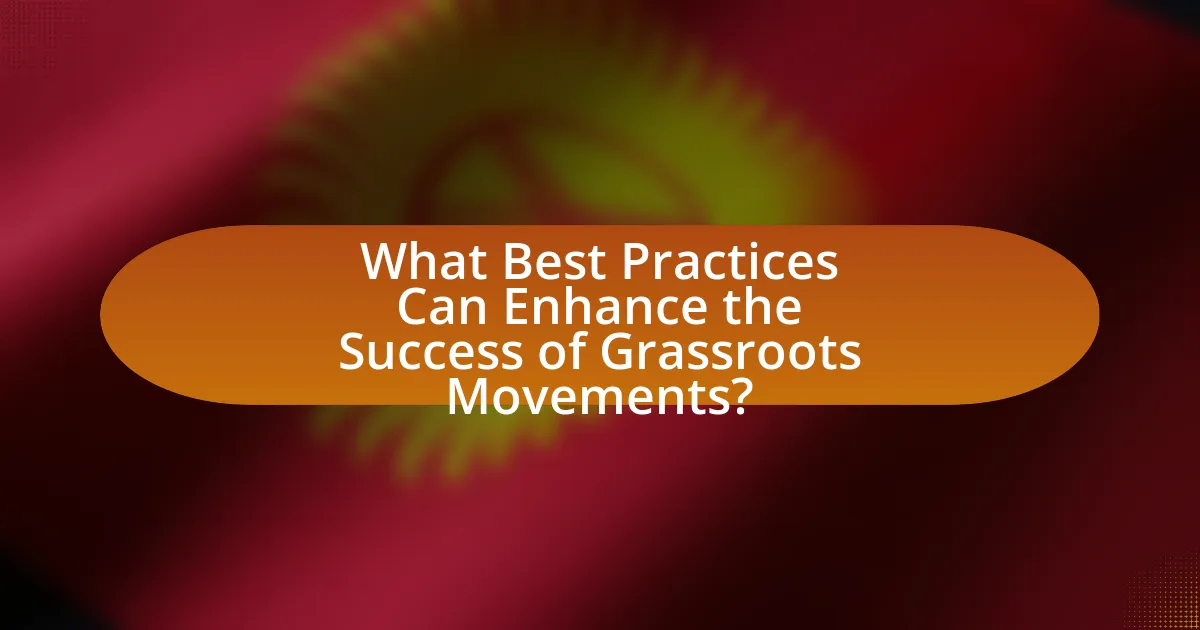
What Best Practices Can Enhance the Success of Grassroots Movements?
Effective grassroots movements can enhance their success by employing strategic community engagement, clear messaging, and coalition building. Community engagement fosters trust and mobilizes local support, as seen in the Civil Rights Movement, where grassroots organizers effectively involved community members in decision-making processes. Clear messaging ensures that the movement’s goals resonate with a broader audience; for instance, the Women’s March utilized powerful slogans to unify diverse groups around common issues. Coalition building expands resources and influence, exemplified by the environmental movement, which has successfully united various organizations to advocate for climate action. These best practices are supported by historical examples that demonstrate their effectiveness in achieving tangible outcomes.
What are effective communication strategies for grassroots movements?
Effective communication strategies for grassroots movements include utilizing social media platforms, fostering community engagement, and employing storytelling techniques. Social media platforms like Facebook and Twitter enable grassroots movements to reach a wider audience quickly, as evidenced by the success of the #BlackLivesMatter movement, which gained global attention through strategic online campaigns. Community engagement, through town hall meetings and local events, helps build trust and solidarity among members, as demonstrated by the success of the environmental movement in the Pacific Northwest, which mobilized local communities to advocate for policy changes. Additionally, storytelling techniques that highlight personal experiences resonate emotionally with audiences, making campaigns more relatable and impactful, as seen in the narratives used by the LGBTQ+ rights movement to humanize their cause and garner support.
How can social media be leveraged to amplify grassroots efforts?
Social media can be leveraged to amplify grassroots efforts by facilitating rapid communication, mobilizing supporters, and increasing visibility for causes. Platforms like Twitter and Facebook allow grassroots organizations to share their messages widely and engage with a larger audience, which can lead to increased participation in events and campaigns. For instance, the Arab Spring demonstrated how social media was instrumental in organizing protests and spreading awareness, resulting in significant political change across multiple countries. Additionally, studies show that social media campaigns can lead to higher engagement rates; for example, a report by the Pew Research Center found that 69% of adults in the U.S. use social media, providing a vast network for grassroots movements to tap into for support and advocacy.
What role does storytelling play in mobilizing support?
Storytelling plays a crucial role in mobilizing support by creating emotional connections and fostering empathy among audiences. Effective narratives can illustrate the struggles and aspirations of individuals or communities, making abstract issues more relatable and urgent. For instance, grassroots movements like the Civil Rights Movement in the United States utilized personal stories to highlight injustices, which galvanized public support and led to significant legislative changes. Research indicates that stories can increase engagement and retention of information, making them powerful tools for advocacy and mobilization.
What lessons can be drawn from successful grassroots movements?
Successful grassroots movements demonstrate the importance of community engagement and collective action in driving social change. These movements often mobilize individuals around a shared cause, fostering a sense of ownership and empowerment among participants. For instance, the Civil Rights Movement in the United States effectively utilized grassroots organizing to challenge systemic racism, leading to significant legislative changes such as the Civil Rights Act of 1964. This illustrates that grassroots efforts can create substantial political and social impact when they unite diverse voices and leverage local knowledge. Additionally, successful movements often emphasize clear messaging and strategic communication, which helps to galvanize support and maintain momentum.
How can adaptability and resilience contribute to long-term success?
Adaptability and resilience are crucial for long-term success as they enable individuals and organizations to navigate challenges and changes effectively. Adaptability allows for the quick adjustment of strategies in response to evolving circumstances, while resilience fosters the ability to recover from setbacks. For instance, grassroots movements often face opposition and shifting political landscapes; those that adapt their approaches and remain resilient in the face of adversity tend to sustain their efforts and achieve their goals. A study by the Stanford Social Innovation Review highlights that organizations demonstrating high adaptability and resilience are more likely to maintain momentum and achieve lasting impact, as seen in successful movements like the Civil Rights Movement, which adjusted tactics over time to respond to societal changes and opposition.
What are the key takeaways for new grassroots organizers?
New grassroots organizers should prioritize building strong community relationships, as effective organizing relies on trust and collaboration. Engaging local stakeholders fosters a sense of ownership and commitment to the cause, which is crucial for mobilizing support. Additionally, clear communication of goals and strategies is essential; studies show that movements with well-defined objectives are more likely to achieve their aims. For instance, the Civil Rights Movement in the United States effectively utilized grassroots organizing to create a unified front, demonstrating the power of collective action. Lastly, adaptability is vital; successful organizers must be willing to adjust their tactics based on community feedback and changing circumstances, as seen in various global movements that have thrived by responding to the needs of their constituents.

